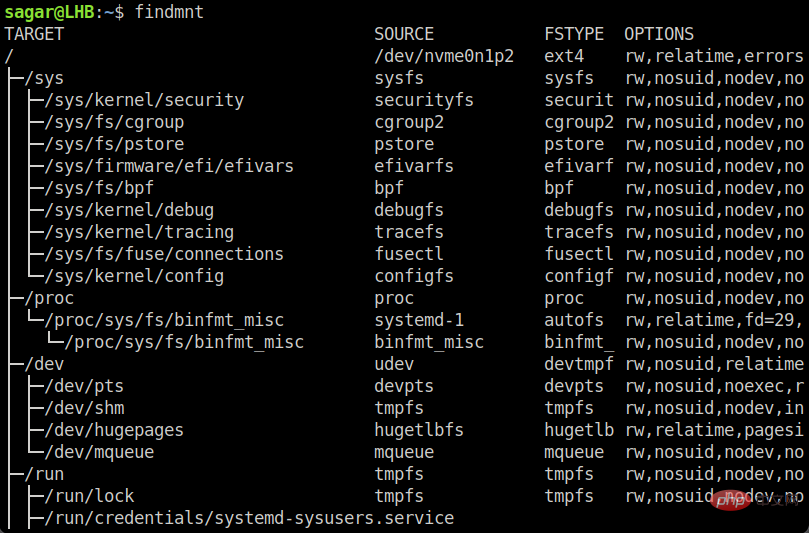How to view disk drive list in Linux
How to view the disk drive list in Linux: 1. Use the findmnt command to view the installed drive list, and the tree layout information will be output; 2. Use the cat command to read the "/proc/mounts" file Contents, you can view the list of installed drives, the syntax is "cat /proc/mounts"; 3. Use the mount command to list the mounted drives, the syntax "mount -l"; 4. Use the df command to list the mounted drives Mounted drive, syntax "df option filename".

#The operating environment of this tutorial: linux7.3 system, Dell G3 computer.
If multiple disk drives are installed in the system and certain operations (such as repartitioning) need to be performed, the disk information needs to be obtained first. To obtain disk drive information, you need to view the list of installed disk drives. This list contains a lot of information about the installed drives.
Use the findmnt command to view the list of installed drives
The easiest way to view the installed disk drives is to use findmnt command:
findmnt

If you don’t like the tree layout information output by findmnt, let’s introduce some other methods below.
Use the cat command to view the list of installed drives
The cat command is used to read document content. Here, we use the cat command to read the contents of the file /proc/mounts:
cat /proc/mounts

The advantage of this method is that it can directly display the installed disk information.
Use the mount command to list Linux Mounted drive
The function of the mount command is described in the man manual as: The mount command is used to mount the file system (filesystem).
In addition to installing drives, you can also use it to obtain installed drive information, including viewing the list of installed drives.
The usage is very simple, just add the -l option after the mount command:
mount -l

In addition, if you want to view a certain file system type of drive, you can use the -t option, as follows:
mount -l -t 磁盘驱动器
For example, I want to view ext4 related information:
mount -l -t ext4

Use the df command to list the mounted drives in Linux
The df command is used to view the available disk space and can also be used to view the installed disk drives.
Use the df command to view the installed disk drive. You need to use 3 options, as shown in the following command:
df [选项] [目录或文件名]
Here:
- -a Get the file system ;
- -T Print file system type;
- -h Output information in human-readable form.
If you want to view the drive of a specific file system type, just add the -t option to the previous options.
For example, in the example we introduced the mount command above, to list the drives of the installed ext4 file system, you can use the following command:
df -a -T -h -t ext4
Related Recommended: "Linux Video Tutorial"
The above is the detailed content of How to view disk drive list in Linux. For more information, please follow other related articles on the PHP Chinese website!

Hot AI Tools

Undresser.AI Undress
AI-powered app for creating realistic nude photos

AI Clothes Remover
Online AI tool for removing clothes from photos.

Undress AI Tool
Undress images for free

Clothoff.io
AI clothes remover

Video Face Swap
Swap faces in any video effortlessly with our completely free AI face swap tool!

Hot Article

Hot Tools

Notepad++7.3.1
Easy-to-use and free code editor

SublimeText3 Chinese version
Chinese version, very easy to use

Zend Studio 13.0.1
Powerful PHP integrated development environment

Dreamweaver CS6
Visual web development tools

SublimeText3 Mac version
God-level code editing software (SublimeText3)

Hot Topics
 1667
1667
 14
14
 1426
1426
 52
52
 1328
1328
 25
25
 1273
1273
 29
29
 1255
1255
 24
24
 Linux Architecture: Unveiling the 5 Basic Components
Apr 20, 2025 am 12:04 AM
Linux Architecture: Unveiling the 5 Basic Components
Apr 20, 2025 am 12:04 AM
The five basic components of the Linux system are: 1. Kernel, 2. System library, 3. System utilities, 4. Graphical user interface, 5. Applications. The kernel manages hardware resources, the system library provides precompiled functions, system utilities are used for system management, the GUI provides visual interaction, and applications use these components to implement functions.
 vscode Previous Next Shortcut Key
Apr 15, 2025 pm 10:51 PM
vscode Previous Next Shortcut Key
Apr 15, 2025 pm 10:51 PM
VS Code One-step/Next step shortcut key usage: One-step (backward): Windows/Linux: Ctrl ←; macOS: Cmd ←Next step (forward): Windows/Linux: Ctrl →; macOS: Cmd →
 How to check the warehouse address of git
Apr 17, 2025 pm 01:54 PM
How to check the warehouse address of git
Apr 17, 2025 pm 01:54 PM
To view the Git repository address, perform the following steps: 1. Open the command line and navigate to the repository directory; 2. Run the "git remote -v" command; 3. View the repository name in the output and its corresponding address.
 How to run java code in notepad
Apr 16, 2025 pm 07:39 PM
How to run java code in notepad
Apr 16, 2025 pm 07:39 PM
Although Notepad cannot run Java code directly, it can be achieved by using other tools: using the command line compiler (javac) to generate a bytecode file (filename.class). Use the Java interpreter (java) to interpret bytecode, execute the code, and output the result.
 How to run sublime after writing the code
Apr 16, 2025 am 08:51 AM
How to run sublime after writing the code
Apr 16, 2025 am 08:51 AM
There are six ways to run code in Sublime: through hotkeys, menus, build systems, command lines, set default build systems, and custom build commands, and run individual files/projects by right-clicking on projects/files. The build system availability depends on the installation of Sublime Text.
 What is the main purpose of Linux?
Apr 16, 2025 am 12:19 AM
What is the main purpose of Linux?
Apr 16, 2025 am 12:19 AM
The main uses of Linux include: 1. Server operating system, 2. Embedded system, 3. Desktop operating system, 4. Development and testing environment. Linux excels in these areas, providing stability, security and efficient development tools.
 laravel installation code
Apr 18, 2025 pm 12:30 PM
laravel installation code
Apr 18, 2025 pm 12:30 PM
To install Laravel, follow these steps in sequence: Install Composer (for macOS/Linux and Windows) Install Laravel Installer Create a new project Start Service Access Application (URL: http://127.0.0.1:8000) Set up the database connection (if required)
 git software installation
Apr 17, 2025 am 11:57 AM
git software installation
Apr 17, 2025 am 11:57 AM
Installing Git software includes the following steps: Download the installation package and run the installation package to verify the installation configuration Git installation Git Bash (Windows only)





